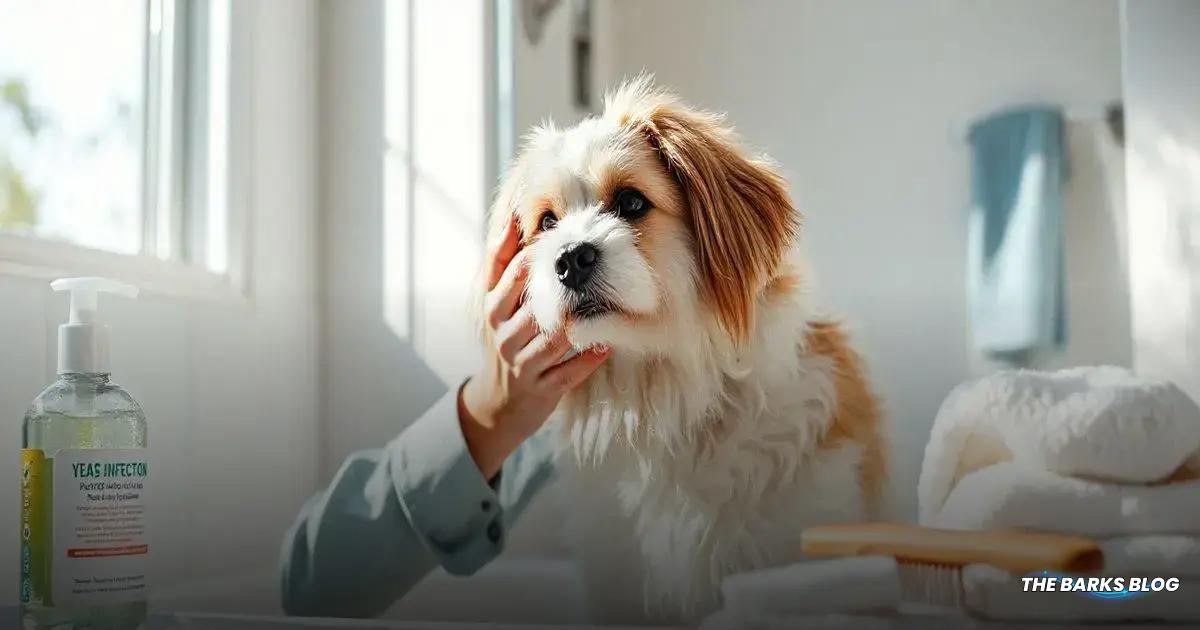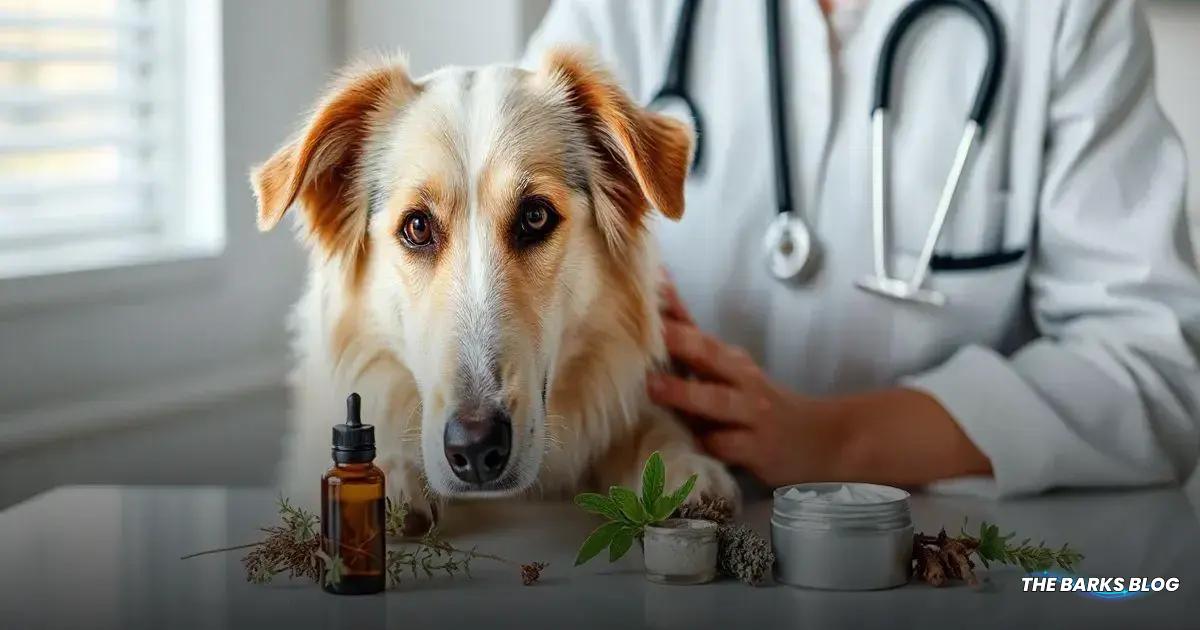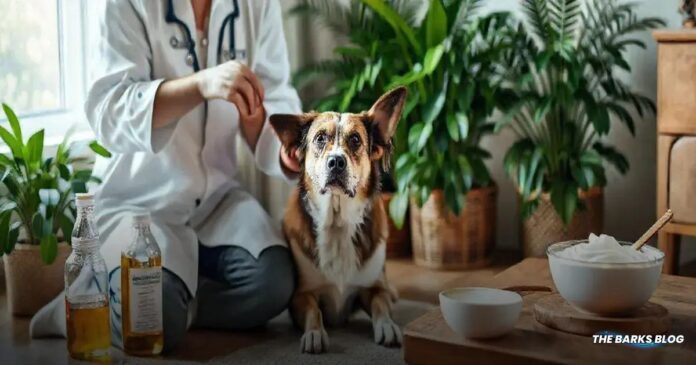Managing yeast infections in dogs requires regular grooming to keep the skin clean, the use of natural topical anti-fungals like coconut oil and apple cider vinegar for relief, and a balanced diet low in sugar and high in quality protein to support a healthy microbiome. Probiotics can also help prevent yeast overgrowth. Consulting with a veterinarian is essential for effective management and ensuring your dog remains comfortable and healthy.
If your dog is prone to yeast infections, you’re likely looking for a reliable dog yeast infection remedy. Yeast infections can lead to uncomfortable symptoms, and addressing them promptly is essential.

Understanding Yeast Infections in Dogs
Understanding yeast infections in dogs is crucial for pet owners, especially those with breeds prone to these uncomfortable conditions. Yeast infections are often caused by an overgrowth of a type of fungus called Malassezia, which is naturally present on the skin. However, when the balance of microorganisms is disrupted, it can lead to infections.
Common signs of yeast infections include smelly, greasy skin that may appear red and inflamed. Dogs may also exhibit itching, scratching, and even hair loss in affected areas. In some cases, the ears can become particularly problematic, leading to ear infections that accompany skin issues.
Several factors can contribute to the development of yeast infections in dogs. A weakened immune system, often due to underlying health issues like allergies, thyroid problems, or diabetes, can make dogs more susceptible. Additionally, poor grooming practices and diets high in sugar can exacerbate the problem, as yeast thrives on sugars.
It’s important for pet owners to recognize these symptoms early and seek veterinary advice if they suspect a yeast infection. A veterinarian can confirm the diagnosis through skin scrapings or tape tests and recommend appropriate treatments to restore balance to your dog’s skin health.
By understanding the causes and symptoms of yeast infections, pet owners can take proactive steps to prevent and manage these conditions, ensuring their furry friends remain healthy and comfortable.

Daily Grooming Practices
Implementing daily grooming practices is essential for managing and preventing yeast infections in dogs. Regular grooming helps to keep your dog’s coat clean and free from debris, which can harbor yeast and other harmful microorganisms.
Start by bathing your dog with a prescription anti-fungal shampoo recommended by your veterinarian. It’s important to massage the shampoo into your dog’s skin and coat, allowing it to sit for at least 15 minutes before rinsing. This contact time is crucial for effectively combating yeast on the skin.
Brushing your dog daily not only helps to remove dirt and loose hair but also distributes natural oils and beneficial microflora throughout the coat. This is a great opportunity to check for any early signs of a yeast infection, such as redness or irritation. Pay special attention to areas where moisture can accumulate, like skin folds or under the ears.
For dogs with wrinkles or skin folds, using chlorhexidine wipes can help keep these areas clean and dry, preventing yeast growth. It’s also vital to clean your dog’s ears regularly, especially if they are prone to ear infections. Aim to clean their ears once a week using a vet-approved ear cleaner, as yeast can thrive in moist environments.
By establishing a consistent grooming routine, you can significantly reduce the risk of yeast infections and keep your dog feeling fresh and comfortable. Remember, regular grooming is not just about aesthetics; it’s a vital part of your dog’s overall health and well-being.

Natural Topical Anti-Fungals
Using natural topical anti-fungals can be an effective way to manage yeast infections in dogs. One of the most popular and accessible options is 100% virgin coconut oil. This natural remedy contains fatty acids that possess anti-fungal properties, helping to combat yeast overgrowth without harming the essential friendly bacteria on your dog’s skin.
To apply coconut oil, simply massage it into the affected areas of your dog’s skin. This not only helps to reduce yeast levels but also promotes healing from any skin irritation caused by the infection. Interestingly, many dogs enjoy the taste of coconut oil, so if they lick it off, it can also provide additional benefits for their skin and gut health. For added benefits, consider incorporating a teaspoon of coconut oil into their food daily, adjusting the amount based on their weight.
Another natural option is apple cider vinegar, which can be diluted with water and applied topically to the affected areas. Its acidic properties help restore the skin’s pH balance, making it less hospitable to yeast. However, be cautious and avoid applying it to broken skin, as it may cause irritation.
Additionally, tea tree oil, known for its anti-fungal and antibacterial properties, can be used as a topical treatment. However, it should always be diluted with a carrier oil (like coconut oil) before application, as undiluted tea tree oil can be harmful to dogs. Always consult your veterinarian before using essential oils to ensure they are safe for your specific dog.
Incorporating these natural topical anti-fungals into your dog’s routine can help manage yeast infections effectively, providing relief and promoting healthier skin. Remember to always monitor your dog for any adverse reactions and consult your vet for personalized advice.

Supporting Your Dog’s Microbiome
Supporting your dog’s microbiome is a crucial aspect of preventing and managing yeast infections. The gut microbiome consists of a diverse community of microorganisms that play a vital role in your dog’s overall health, including their immune system and digestion.
One of the primary ways to maintain a healthy microbiome is by focusing on your dog’s diet. High-sugar diets can promote yeast growth, so it’s essential to reduce sugar intake and opt for high-quality protein sources. Look for dog foods that list meat as the first ingredient and avoid those with fillers or excessive carbohydrates.
Incorporating probiotics into your dog’s diet can also be beneficial. Probiotics are live beneficial bacteria that help restore balance to the gut microbiome, preventing the overgrowth of harmful organisms like yeast. You can find probiotic supplements specifically formulated for dogs, which can be added to their food daily.
Additionally, consider including natural sources of probiotics, such as plain, unsweetened yogurt or kefir, in your dog’s diet. These can help introduce good bacteria to their digestive system and promote a healthy balance.
It’s also important to monitor your dog’s overall health and address any underlying conditions that could affect their immune system. Regular veterinary check-ups can help identify issues such as allergies or hormonal imbalances that may contribute to yeast infections.
By taking proactive steps to support your dog’s microbiome through diet, probiotics, and regular health monitoring, you can significantly reduce the risk of yeast infections and enhance your dog’s overall well-being.
Conclusion
Managing your dog’s yeast infection can be challenging, but with consistent care and the right strategies, you can help keep it under control.
By implementing daily grooming practices, utilizing natural topical anti-fungals, and supporting your dog’s microbiome, you can significantly reduce the frequency and severity of yeast infections.
Remember, a healthy diet low in sugar and high in quality protein is essential for maintaining a balanced gut microbiome, which in turn supports your dog’s immune system.
Regular veterinary consultations are crucial for identifying and addressing any underlying health issues that may contribute to yeast overgrowth.
By staying proactive and attentive to your dog’s needs, you can ensure they lead a happy, itch-free life, free from the discomfort of yeast infections.
Your commitment to their health will make all the difference in their well-being.
FAQ – Frequently Asked Questions about Dog Yeast Infections
What are the common symptoms of a yeast infection in dogs?
Common symptoms include smelly, greasy skin, redness, inflammation, itching, scratching, and hair loss in affected areas.
How can I prevent yeast infections in my dog?
Preventing yeast infections involves regular grooming, maintaining a healthy diet low in sugar, and supporting your dog’s microbiome with probiotics.
Can I use coconut oil for my dog’s yeast infection?
Yes, 100% virgin coconut oil can be applied topically to help manage yeast infections and can also be added to their food for additional benefits.
Is it safe to use apple cider vinegar on my dog’s skin?
Diluted apple cider vinegar can be applied to the skin, but avoid using it on broken skin as it may cause irritation.
How often should I clean my dog’s ears to prevent yeast infections?
If your dog is prone to ear infections, aim to clean their ears once a week using a vet-approved ear cleaner.
When should I consult a veterinarian about my dog’s yeast infection?
If you notice persistent symptoms or if your dog’s condition worsens, it’s important to consult your veterinarian for a proper diagnosis and treatment plan.




